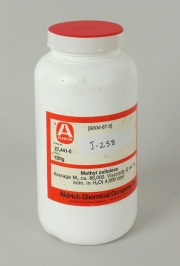Methyl cellulose
Description
A cellulose ether with a methyl functional group substitution. Methyl cellulose (MC) is a fibrous, somewhat fluffy, white powder that is used as a synthetic substitute for natural gums. It forms a highly viscous colloidal solution in cold water that reversibly gels when heated. Methyl cellulose dries to a clear film with very little shrinkage. It has been used as a substitute for Gelatin and Glue in sizing paper and has been used as an adhesive in textile and paper conservation (Kuhn 1986). Methyl cellulose has also been used as a poulticing material to pick up stains; as a poultice the addition of Fumed silica minimizes depth penetration while the addition of Glycerin adds flexibility. Methyl cellulose is sometimes found as a binder in pastels and watercolor paints. In industry, methyl cellulose is used as a lubricant, suspension aid and emulsifier. It is used in foods, leather tanning and cosmetics. Aging studies indicate that methyl cellulose (MC) polymers have very good stability with negligible discoloration or weight loss (Feller and Wilt 1990).
Synonyms and Related Terms
MC; metilcelulosa (Esp.); méthylcellulose (Fr.); metil cellulosa (It.); metilcelulose (Port.); methylcellulose; cellulose methyl ether; cellulose methylate; elastic vegetable glue
Examples: Methocel [Dow]; Polycell; Tylose® MB [Hoechst]; Glutolin; Sicho-Zell; Cellothyl; Syncelose; Celevac; Cellumeth; Hydrolose; Nicel; Culminal [Aqualon]; Methofas® [ICI, England]
Other Properties
Soluble in cold water, ethylene glycol. Insoluble in hot water, ethyl ether. Most commercial products have a degree of substitution of 1.5-1.9.
| Composition | (C7H14O5)n |
|---|---|
| CAS | 9004-67-5 |
| Refractive Index | 1.49 |
Hazards and Safety
Dust may cause irritation to eyes and lungs. Dust is flammable. Flash point = 140C
Fisher Scientific: MSDS
Additional Information
° R.Feller, M.Wilt, Evaluation of Cellulose Ethers for Conservation, in Research in Conservation Series, Getty Conservation Institute, 1990. ° H.Kuhn, Conservation and Restoration of Works of Art and Antiquities, Butterworths, London, 1986.
Comparisons
Physical Properties for Selected Thermoplastic Resins
General Characteristics of Polymers
Sources Checked for Data in Record
- Rachael Perkins Arenstein, Lisa Goldberg, and Eugenie Milroy, ‘Support and Rehousing for Collection Storage’ In ‘Preventive Conservation: Collection Storage’ Lisa Elkin and Christopher A. Norris (eds.), Society for the Preservation of Natural History Collections, New York. 2019.
- G.S.Brady, Materials Handbook, McGraw-Hill Book Co., New York, 1971 Comment: p. 169
- Richard S. Lewis, Hawley's Condensed Chemical Dictionary, Van Nostrand Reinhold, New York, 10th ed., 1993
- Random House, Webster's Encyclopedic Unabridged Dictionary of the English Language, Grammercy Book, New York, 1997
- The Merck Index, Martha Windholz (ed.), Merck Research Labs, Rahway NJ, 10th edition, 1983 Comment: entry 6120
- Matt Roberts, Don Etherington, Bookbinding and the Conservation of Books: a Dictionary of Descriptive Terminology, U.S. Government Printing Office, Washington DC, 1982
- Hermann Kuhn, Conservation and Restoration of Works of Art and Antiquities, Butterworths, London, 1986
- Kurt Wehlte, The Materials and Techniques of Painting, Van Nostrand Reinhold Co., New York, 1975
- Book and Paper Group, Paper Conservation Catalog, AIC, 1984, 1989

